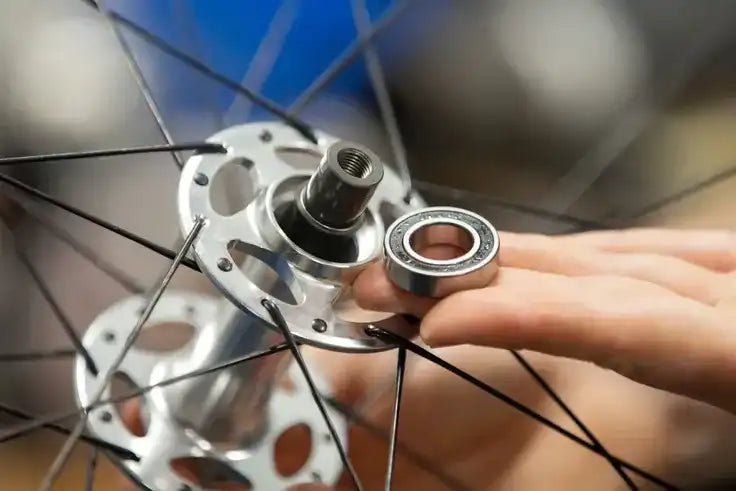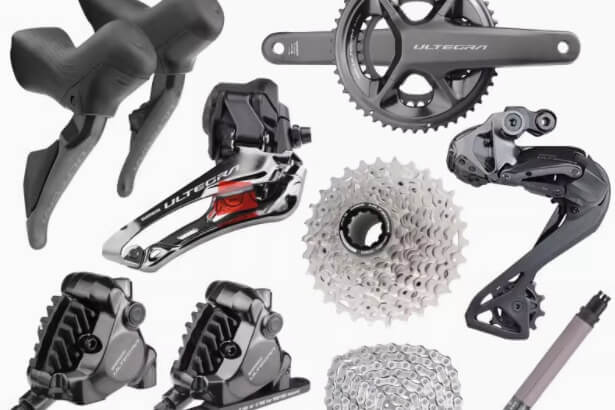In the world of bicycles, bearings are often overlooked, but they are the core components that keep your bike rolling smoothly. Without bearings, the steering, rolling, pedaling, and drivetrain of a bicycle cannot function properly. From hubs to bottom brackets, from headsets to suspension pivots, to pedals and gearshifts, many parts of a bicycle are inseparable from bearings.
Today, we will take a deep look at all aspects of bicycle bearings.
1. Different types of bearings on bicycles

A bushing, also known as a bushing or plain bearing, is a simple sleeve that sits between two surfaces to reduce friction. It is commonly found in shock mounts, cheaper pulleys and gearshifts, and sometimes in pedals, usually working in conjunction with bearings.
Looking inside the Crankbrothers Stamp pedal, the double custom igus bushings used to achieve a low stack height are very eye-catching.
(II) Loose ball bearings (cup and cone bearings)


Loose ball bearings are angular contact bearings that are relatively easy to maintain and perform well when properly adjusted.
There are also ball and cage systems, which are similar to loose ball bearings but are cheaper to assemble and are often used in entry-level components. Some high-performance caged bearings, such as Campagnolo's CULT bearings and Cane Creek's Hellbender Neo bearings, also perform very well.
(III) Sealed bearings

It is the most common type of bearing in all but the cheapest bicycles and is usually pressed into the bearing hole.


Sealed bearing systems require high-precision operation and are increasingly used as manufacturing technology advances.
(IV) Needle roller bearings


The bearings in needle roller bearings are cylindrical tubes rather than balls, which can create smooth rolling and stable platforms under high loads, but it is expensive and complicated to manufacture a good mating surface and is prone to fatigue.
For this reason, they are often replaced by multi-row sealed bearings to achieve the same effect.
2. Standards for high-quality bearings
Bearings are often referred to as "ABEC" followed by a number. The higher the number, the better the quality. However, the ABEC standard does not take into account load handling capacity, ball accuracy, and Rockwell hardness.
Generally speaking, ABEC 3 and 5 are suitable for bicycle components, and 7 and 9 grades are too precise for bicycles.
Factors such as seals, materials, and grease are more important to bicycle bearing performance.
3. Guide to bearing seals
(I) Importance of seals
Sealed bearings usually have two rubber seals on both sides, which have a great impact on the overall performance of the bearing.
Friction, protection, and maintainability of seals are three major considerations.
Although less friction is better, a little friction may mean better protection.
Seals can prevent contaminants from entering and keep grease inside.
For most high-quality bearings, the seals can be carefully removed with a small blade for maintenance.
(II) Seal types
Bicycle bearings can be divided into single seals, double seals, and labyrinth seals.
Single seals are simple covers that clamp onto the outer edge of the bearing track and are susceptible to contamination;
Double seals have a second dust cover that is less susceptible to contamination;
Labyrinth seals provide a tortuous path to prevent dust and water from entering, but may add additional friction.
4, bearing materials
Bearings are made of a variety of materials, such as chrome steel, 440C stainless steel, XD15 super nitrogen stainless steel, and silicon nitride (ceramic bearings).
Generally speaking, the harder the material, the better, but there is a point of diminishing returns. Too hard will make the ball brittle and may cause different wear with the bearing track.
Brands need to consider factors such as application location, maintenance level, and budget when choosing bearing materials.
5, the benefits of ceramic bearings

Ceramic bearings are five times harder than steel bearings, have less friction when rolling, are manufactured to tighter tolerances, have balls that are closer to spherical, require less and lighter lubricants, and can save 6 to 9 watts of power.
However ceramic bearings may require more frequent maintenance, and high-quality steel bearings may perform better than low-quality ceramic bearings.
6. How to maintain bearings

Bearings need maintenance like other moving parts on a bicycle. There is no such thing as a "fit and forget" bearing.
Maintenance usually includes removing the bearing, removing old lubricant with a degreaser, checking the ball and bearing tracks for wear, and relubricating or replacing the bearing.
For loose ball bearings, the tightness of the cup and cone should be adjusted carefully.
Improper installation of sealed bearings can easily lead to premature wear. A professional bearing press can ensure correct installation.
There is a reason why angular contact-bearing seals have different colors. The black seal should face the centerline and the red one should face the outside.

Proper bearing maintenance ends with the appropriate lubricant. The manufacturer or bicycle shop can be consulted to determine the best lubricant. The choice depends on the application, the type of bearing system, the frequency of maintenance, and the type of environmental exposure.
Tags: #bicycle bearings #sealed bearings #loose ball bearings #ceramic bearings #bearing care #Superteamwheels




Dejar un comentario
Todos los comentarios se revisan antes de su publicación.
Este sitio está protegido por hCaptcha y se aplican la Política de privacidad de hCaptcha y los Términos del servicio.